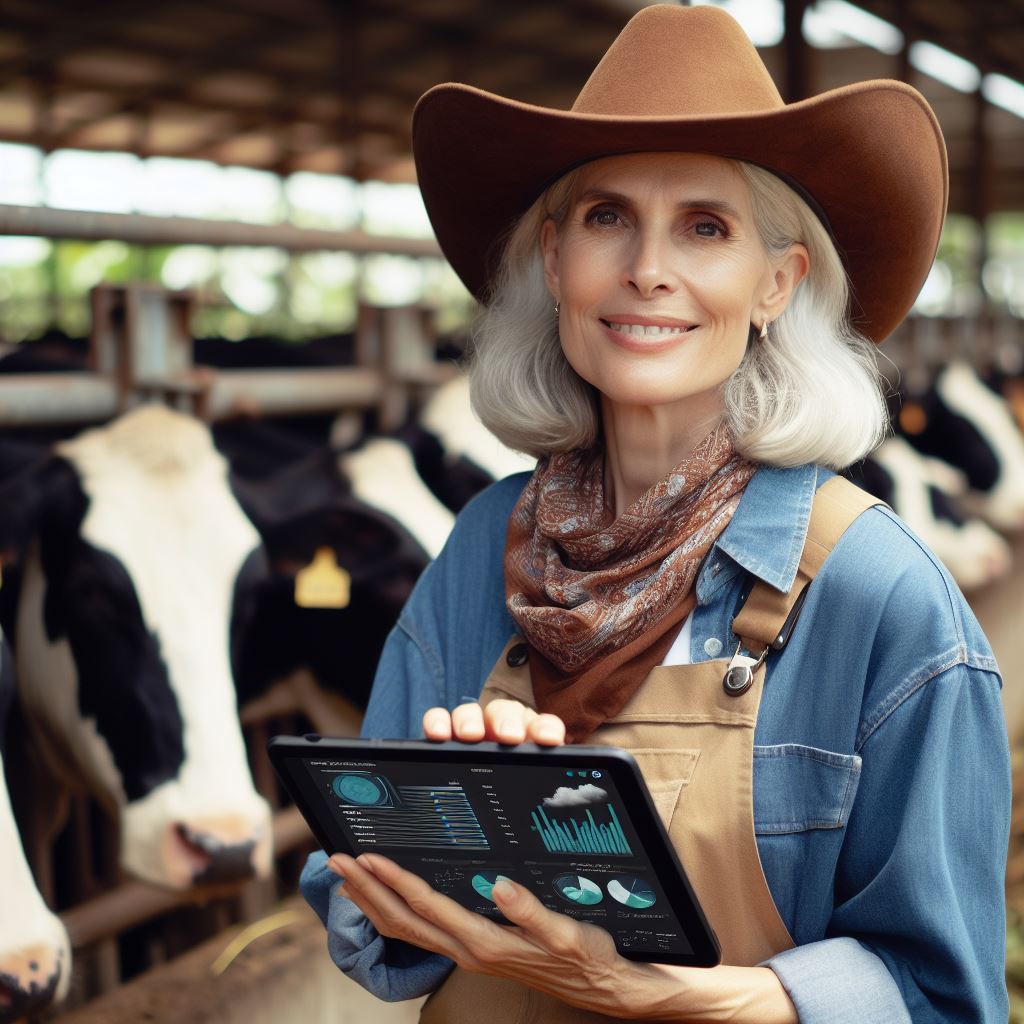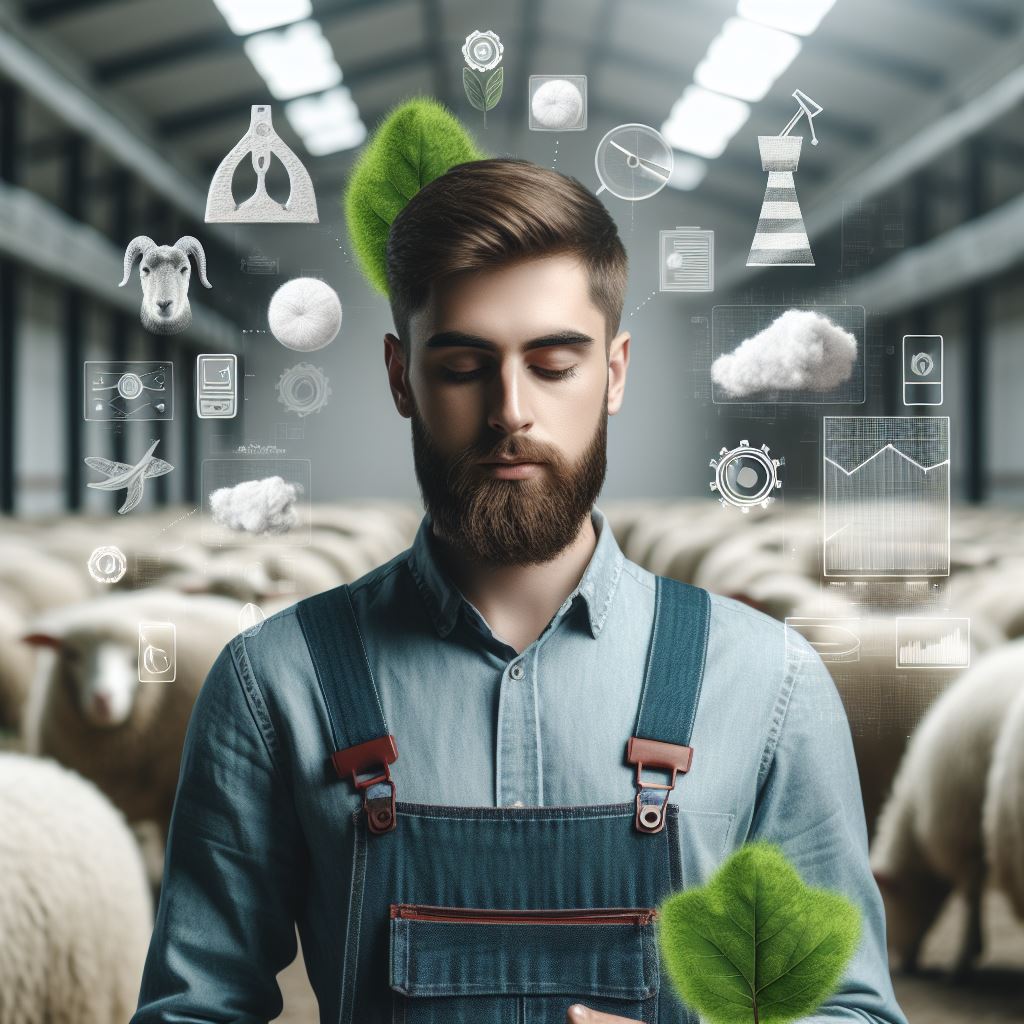Introduction
Climate-smart cattle farming is an innovative approach that addresses environmental challenges while ensuring sustainable livestock production.
This proactive strategy combines technological advancements, sustainable management, and resilience against climate change impacts.
As global temperatures rise and weather patterns shift, the agricultural sector, including cattle farming, faces unprecedented challenges.
The introduction of climate-smart practices aims to mitigate these challenges and create a more sustainable and resilient future.
Harnessing scientific knowledge and modern technologies, climate-smart cattle farming seeks to optimize productivity without compromising environmental integrity.
This introduction sets the stage for exploring the multifaceted strategies that make climate-smart cattle farming a promising solution for the future.
The Role of Cattle Farming in Climate Change
As we continue our exploration of climate-smart cattle farming, it is crucial to understand the significant role that this industry plays in climate change.
Cattle farming has a profound impact on greenhouse gas emissions, deforestation, and the release of methane – a potent contributor to the current climate crisis.
Impact of Cattle Farming on Greenhouse Gas Emissions
Cattle farming is a major source of carbon dioxide (CO2), methane (CH4), and nitrous oxide (N2O) emissions.
These gases trap heat in the atmosphere, leading to the greenhouse effect and subsequently causing global warming.
- Enteric Fermentation: The digestive process of ruminant animals like cows produces methane, accounting for a significant portion of greenhouse gas emissions.
- Manure Management: Improper handling and storage of livestock waste, especially in intensive farming systems, release substantial amounts of methane and nitrous oxide into the atmosphere.
Deforestation and its Connection to Cattle Ranching
Cattle ranching is significantly linked to deforestation, especially in regions like the Amazon rainforest, resulting in adverse environmental consequences.
- Clearing Forests for Pastures: Large areas of forests are cleared to create space for grazing cattle, leading to habitat destruction and loss of biodiversity.
- Land Conversion for Soy Production: Soy is a prevalent feed crop in the livestock industry, and the expansion of soybean plantations often drives deforestation.
Methane Emissions from Cattle and its Contribution to Climate Change
The release of methane from cattle farming is a major concern as it is a potent greenhouse gas with a significantly higher heat-trapping capacity than carbon dioxide.
- Methane’s Global Warming Potential: Even though methane’s lifespan in the atmosphere is shorter than CO2, it is 28 times more effective at trapping heat.
- Enteric Fermentation: Ruminant animals possess a specialized digestive system that produces methane during the breakdown of food, contributing to the total greenhouse gas emissions.
Lastly, cattle farming has far-reaching implications for climate change.
It not only leads to increased greenhouse gas emissions but is also intertwined with deforestation, habitat loss, and the release of methane.
However, by adopting climate-smart strategies and implementing sustainable practices, it is possible to mitigate the impact of cattle farming on the environment and work towards a more sustainable future.
Transform Your Agribusiness
Unlock your farm's potential with expert advice tailored to your needs. Get actionable steps that drive real results.
Get StartedRead: Top Feeding Tips for Healthy Sheep
Climate-Smart Practices in Cattle Farming
The agricultural sector plays a significant role in climate change mitigation and adaptation efforts.
Livestock farming, in particular, has a considerable environmental impact, with cattle farming being recognized as a major contributor to greenhouse gas emissions.
However, by adopting climate-smart practices, cattle farmers can minimize their ecological footprint and contribute to a more sustainable future.
Improved pasture management techniques
Rotational grazing allows cattle to graze in one area while other areas recover, promoting healthier pastures.
Including a variety of plants in pastures helps improve soil health, drought resistance, and nutrition for cattle.
Improved pasture management techniques are crucial in climate-smart cattle farming.
Rotational grazing systems, for instance, allow pastures to recover while optimizing cattle grazing.
This approach improves soil health, reduces erosion, and enhances the overall resilience of the ecosystem.
Additionally, diversifying forage species in pastures not only promotes better nutrition for cattle but also increases the land’s resistance to extreme weather events.
Enhanced breeding and genetic selection
Farmers can selectively breed cattle that are better adapted to extreme weather conditions and temperature fluctuations.
By breeding animals with lower methane production, farmers can reduce the environmental impact of cattle farming.
Breeding and genetic selection also play a vital role in climate-smart cattle farming.
Farmers can prioritize breeding cattle that are resilient to changing climatic conditions, such as those tolerant of heat stress or drought.
Moreover, selecting animals with lower methane emissions significantly reduces the environmental impact of cattle farming, as methane is a potent greenhouse gas.
Reforestation and agroforestry
Strategic tree planting helps combat climate change by sequestering carbon and providing shade to grazing cattle.
Trees not only provide shade, but they also act as windbreaks, protecting cattle from extreme weather conditions.
Reforestation and agroforestry practices form another key aspect of climate-smart cattle farming.
Planting trees on pasture land sequesters carbon dioxide from the atmosphere while providing shade and shelter for the grazing cattle.
Integrating trees with grazing areas further benefits the animals by acting as windbreaks, protecting them from harsh environmental conditions.
Water management strategies
Farmers can optimize water use by implementing irrigation systems that minimize water wastage.
Incorporating technologies like automatic waterers and water recycling systems can reduce water consumption on farms.
Effective water management strategies are essential for sustainable cattle farming.
Implementing efficient irrigation methods can optimize water usage, reducing overall water consumption.
Showcase Your Farming Business
Publish your professional farming services profile on our blog for a one-time fee of $200 and reach a dedicated audience of farmers and agribusiness owners.
Publish Your ProfileFurthermore, incorporating water-saving technologies in cattle watering systems, such as automatic waterers and recycling systems, ensures that water resources are used responsibly.
Basically, climate-smart practices in cattle farming are crucial for mitigating the environmental impact of the industry.
By adopting improved pasture management techniques, enhancing breeding and genetic selection, promoting reforestation and agroforestry, and implementing water management strategies, farmers can minimize their carbon footprint and contribute to a more sustainable and climate-resilient future.
It is imperative for the agricultural sector to embrace these practices and strive towards responsible and environmentally conscious cattle farming.
Read: Goat Nutrition: What Your Herd Needs
Benefits of Climate-Smart Cattle Farming
Reduced greenhouse gas emissions
Climate-smart cattle farming practices focus on reducing the release of greenhouse gases.
Implementing proper waste management systems can help minimize methane emissions from cattle.
By adopting sustainable feed production techniques, farmers can reduce the carbon footprint of livestock.
Preservation of natural resources
Climate-smart cattle farming promotes sustainable land and water management practices.
Efficient irrigation systems and rotational grazing help preserve water resources and prevent soil erosion.
By using animal manure as organic fertilizer, farmers reduce dependence on synthetic fertilizers that harm the environment.
Increase in farm productivity and profitability
Climate-smart practices improve the overall health and well-being of cattle, enhancing their productivity.
Implementing better feeding strategies results in improved weight gain and higher milk yields.
Reduced disease incidences and veterinary costs contribute to increased profitability for farmers.
Compliance with sustainable farming standards and certifications
Adopting climate-smart cattle farming practices helps farmers meet international sustainability standards.
Compliance with certifications such as the Global Roundtable for Sustainable Beef demonstrates commitment to environmental stewardship.
Access to premium markets with higher demand for sustainable products can lead to increased market opportunities and profitability.
Overall, climate-smart cattle farming provides various benefits that go beyond environmental conservation.
By reducing greenhouse gas emissions, farmers contribute to combating climate change.
The preservation of natural resources helps maintain healthy ecosystems and supports biodiversity.
Additionally, implementing climate-smart practices enhances farm productivity and profitability.
Compliance with sustainable farming standards and certifications ensures farmers are recognized for their environmental efforts and opens doors to premium markets.
Adopting climate-smart cattle farming is not only a responsible choice but also a strategic one for long-term success in a changing climate.
Read: From Farm to Table: Poultry Processing Insights

Gain More Insights: Pasture Management: Seasonal Strategies
Challenges and Potential Solutions
Financial constraints for implementing climate-smart practices
Limited financial resources often hinder farmers from adopting climate-smart cattle farming practices.
High costs associated with infrastructure development, such as building climate-controlled barns, can be overwhelming.
Searching for cost-effective solutions is crucial to ensure that farmers can embrace climate-smart practices without financial burden.
Farmers can explore options like crowdfunding or seeking financial assistance from government agricultural schemes.
Collaborative efforts between financial institutions and farmers can develop affordable loan plans specifically for climate-smart farming initiatives.
Encouraging private sector investments via partnerships with agribusinesses can address financial constraints.
Lack of knowledge and awareness among farmers
Insufficient awareness hampers farmers’ ability to understand and adopt climate-smart cattle farming practices.
Providing educational workshops and training sessions can equip farmers with the necessary knowledge.
Governments and non-profit organizations should collaborate to organize informative campaigns to raise awareness.
Peer-to-peer learning networks can be established to facilitate knowledge sharing among farmers.
Establishing demonstration farms can enable farmers to observe the benefits of climate-smart practices firsthand.
Building partnerships with educational institutions can facilitate the dissemination of research findings and innovative techniques.
Policy support and incentive mechanisms to promote climate-smart cattle farming
Policy frameworks should prioritize climate-smart practices and recognize their benefits for sustainable agriculture.
Governments need to allocate funds to support research and development in climate-smart cattle farming.
Offering tax benefits or subsidies to farmers embracing climate-smart practices can incentivize adoption.
Showcase Your Farming Business
Publish your professional farming services profile on our blog for a one-time fee of $200 and reach a dedicated audience of farmers and agribusiness owners.
Publish Your ProfileCreating comprehensive guidelines and certification programs can ensure the standardization of climate-smart practices.
Developing collaboration platforms among farmers, policymakers, and scientists can foster knowledge exchange and policy alignment.
Strengthening the link between climate-smart cattle farming and existing climate change policies and agreements can promote adoption.
Ultimately, challenges faced in implementing climate-smart cattle farming practices can be overcome through various strategies.
Financial constraints can be tackled by exploring cost-effective solutions and establishing partnerships with financial institutions and private sector entities.
Lack of knowledge and awareness can be addressed through educational initiatives, peer learning networks, and demonstration farms.
Policy support and incentive mechanisms play a vital role in encouraging farmers to adopt climate-smart practices, and governments should prioritize the integration of climate-smart farming into policy frameworks.
By effectively addressing these challenges, the potential for widespread adoption of climate-smart cattle farming practices can be realized, contributing to a more sustainable and resilient agricultural sector.
Read: Shearing Techniques for Sheep: A Guide
Gain More Insights: Pig Fertility: Breeding Best Practices
Case Study: Successful Climate-Smart Cattle Farming Model
Specific farm’s adaptation of climate-smart practices
- Meadows Farm, a cattle farm in rural Texas, successfully implemented climate-smart practices.
- They designed an efficient water management system to cope with sporadic rainfall.
- Investing in improved pasture management, they adopted rotational grazing techniques.
- Using solar-powered electric fences, Meadows Farm managed to reduce their carbon footprint.
- Meadows Farm adapted their feeding method, relying more on locally sourced and sustainable feed options.
- They also created shaded areas to protect cattle from extreme heat and minimize heat stress.
- By implementing these practices, Meadows Farm ensured the resilience of their cattle and increased productivity.
The positive outcomes and lessons learned
- As a result of climate-smart practices, Meadows Farm experienced improved water efficiency and conservation.
- The rotational grazing technique led to enhanced soil health and reduced soil erosion.
- Utilizing renewable energy lowered Meadows Farm’s electricity bills and decreased dependence on fossil fuels.
- By incorporating locally sourced feed, Meadows Farm supported the local economy and reduced transportation emissions.
- The creation of shaded areas decreased cattle mortality rates due to extreme heat.
- Meadows Farm’s successful implementation of climate-smart practices attracted government grants and funding opportunities.
- Lessons learned include the importance of continuous adaptation to changing climate conditions.
- Meadows Farm realized the significance of investing in sustainable infrastructure for long-term benefits.
- Collaboration with experts and local communities improved knowledge sharing and overall success.
- Monitoring and evaluating the impact of climate-smart practices helped in making necessary adjustments.
- Meadows Farm acknowledged the need to share their success stories to inspire and encourage other farmers.
Overall, Meadows Farm’s adoption of climate-smart practices highlights the potential for successful and sustainable cattle farming in the face of climate change.
By implementing water management systems, rotational grazing, renewable energy, and locally sourced feed, they achieved positive outcomes in water efficiency, soil health, energy conservation, and economic support.
Lessons learned from their experience emphasize the importance of adaptation, infrastructure investment, collaboration, monitoring, and knowledge-sharing.
Meadows Farm serves as a role model and inspiration for other farmers to embrace climate-smart techniques and contribute to a resilient and environmentally conscious agricultural sector.
Explore Further: Beef Cattle Genetics: Traits for Better Beef
See Related Content: Integrating Livestock: Poultry with Other Farm Animals
Conclusion
Integrating climate-smart practices fortifies cattle farming against environmental challenges, ensuring sustainability and resilience.
Adapting to changing climates secures the livelihoods of farmers, fostering economic stability and growth.
Utilizing efficient resource management reduces environmental impact, promoting a balance between productivity and ecological conservation.
Implementing innovative technologies optimizes production while minimizing the carbon footprint, exemplifying forward-thinking in agriculture.
The symbiotic relationship between climate-smart strategies and cattle farming underscores the industry’s capacity for positive transformation.
As we conclude, the future of cattle farming hinges on a commitment to climate-smart principles, safeguarding both the industry and the planet.




